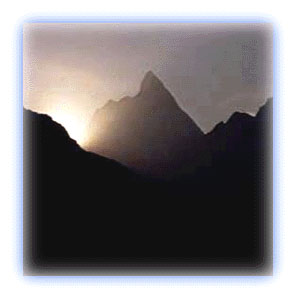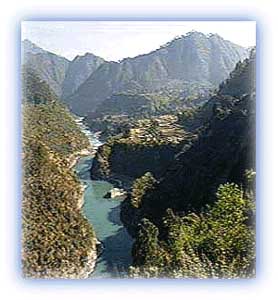Garhwal himalayas
General info
· Uttarakhand
· Eastern Garhwal
· Route to Badrinath
· Haridwar
· Rishikesh
· Devaparayag
· Srinagar
· Rudraprayag
· Chamoli
· Joshimath
· Badrinath
· Mana and Niti
· Valley of Flowers
· Hemkund Sahib
· Route to Kedarnath
Nanda Devi
· Inner Sanctuary
· Outer Sanctuary
· Present-day Scenario
· Western Garhwal
Other Places of Interest
· Uttarkashi
People
· Jaunsaries
· Jadhs
· Marchas
· Bhotias
Religion
· Gods and Goddesses
Flora and Fauna
· Wildlife

![]()
The center piece of the Garhwal region is undoubtedly the Nanda Devi Sanctuary. Until 1934, the gorge of the Rishiganga River and the immediate area around Nanda Devi was one of the least known and most inaccessible parts of the Himalayas. In the sanctuary, the mountains stand in a vast amphitheater, seventy miles in circumference and about 6,000 m high. There is no depression in this cirque below 5,200 m except in the west where the Rishi ganga has carved out for itself one of the most formidable gorges in the world. The Nanda Devi Sanctuary is drained in part by the Alaknanda and Saraswati rivers. |
The early Indian surveyors and mountaineers alike were unable to venture into the Inner Sanctuary. Famous mountaineers like Longstaff, Bruce, Ruttledge, Wilson and Somervell all made attempts to cross the gorge, but in vain. It was in 1934 that Eric Shipton and Bill Tilman eventually managed to find their way to the Sanctuary. This paved the way for the Anglo-American mountain expedition of 1936 to ultimately climb the peak. When Tilman and Odell reached the top of Nanda Devi on August 29, 1936, they had reached the highest point ever climbed by man till then. And this record stood till the French stood on top of Annapurna in Nepal in 1950 -- the first 8,000 m peak to be climbed by man.
 |
| Nanda Devi, from Auli Credit: Karamjeet Singh |
Nanda Devi
Nanda Devi may not even be one of the highest twenty peaks in
the world, but interestingly, at one point in time, she did
enjoy the singular status of being the highest mountain in the
British empire -- the world's largest empire. The reason for
this was that Mount Everest lay in the Kingdom of Nepal and K2
lay in the princely state of Kashmir.
Standing at a fantastic height of 7,816 m above sea level, the Nanda Devi is a mountain that has influenced the population of the region since time immemorial. Scintillatingly beautiful viewed from any angle, it is the patron Goddess of Garhwal and Kumaon.
The Nanda Devi massif stands alone, encircled in a vast ring of lesser peaks seventy miles in circumference. In this ring are no fewer than nineteen peaks over 21,000 ft and no known break below 17,000 ft, except in the west, up the incredible gorge of the Rishi Ganga.
All rights reserved
